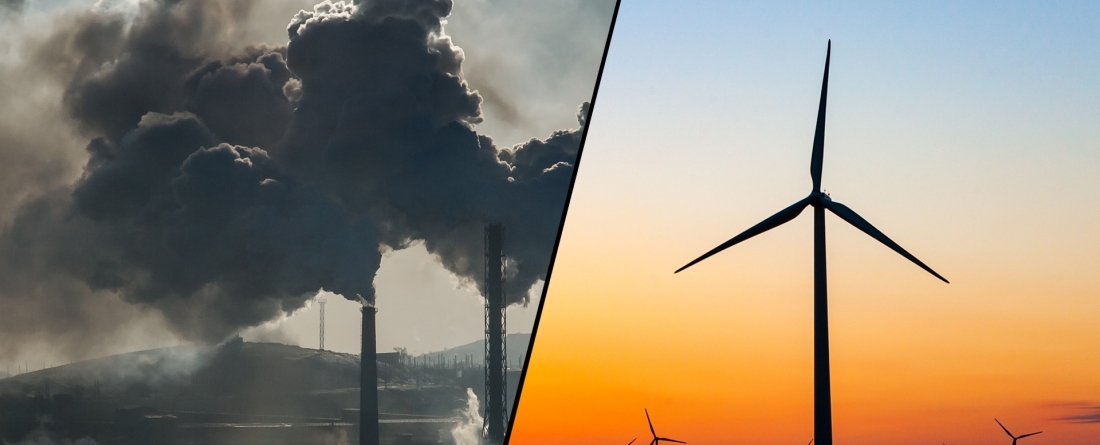
(Smokestacks photo by iStock; windmills by John T. Consoli)
Via Maryland Today / By Chris Carroll
From Changing Politics to Tech Advances, UMD Climate Policy Expert Outlines Optimism on This Earth Day
President Joe Biden this morning rolled out a new climate plan committing the U.S. to slashing its greenhouse gas emissions to half of 2005 levels, or less, by decade’s end. It's a challenging goal, but one that many climate scientists and policymakers agree would help keep the world on track to reach net zero emissions by 2050 and avoid drastic outcomes of climate change, from widespread flooding to droughts and increased disease.
Here’s the good news this Earth Day, according to a University of Maryland researcher and a leading U.S. voice on climate policy: Not only are such cuts within our reach as a nation, we’re already well on our way—and continuing to push can actually boost our economy while protecting the planet’s future.
“This is absolutely an ambitious goal, but it is one that’s possible,” said Nathan Hultman, associate professor of public policy, founder and director of the Center for Global Sustainability and a former Obama White House climate policy adviser. He spoke with Maryland Today to outline reasons for optimism:
The administration has hopped back on the Paris train
While former President Donald Trump pulled the U.S out of the Paris Climate Accord (which ironically took effect only in January, after he had lost his reelection bid) and hindered federal agencies’ efforts to reduce emission reductions, the man who defeated Trump is pulling in the opposite direction and making climate action a government-wide marching order. “The president doesn't have infinite power, but is an organizing force in the federal government. This president has clearly demonstrated his intent to be ambitious,” Hultman said.
Bottom-up climate action already teed us up for national success
Even when the U.S. government was on the sidelines, subnational actors—states, cities, corporations, universities like UMD—banded together and kept the United States close to what the Obama administration committed to when the 2015 Paris agreement was signed, of 26% to 28% reductions by 2025. The UMD Center for Global Sustainability helped drive this movement as analytical leads for the America’s Pledge and America Is All In initiatives, which have created a framework for subnational action.
Recent analyses led by Hultman and the CGS team have demonstrated the aggregate emissions impact of such actions, and showed that the last four years did not simply hold the line against climate change, but advanced policies, technologies and behaviors aimed a decarbonizing the economy. “It’s unequivocally the case that the starting point today is much, much better than if we had been doing nothing, making national success now possible,” Hultman said. Another recent CGS analysis demonstrates the U.S. can surpass 50% emissions reductions by 2030, driven by new federal actions build on this subnational base.
Necessary technology is already here
From green energy to highly efficient vehicles, the technologies required to hit the 2030 goal exist, Hultman said, and in many cases are cheaper than fossil fuel alternatives. Solar power costs, for instance, have plummeted more than 80% in a decade, while wind power costs have also fallen dramatically. Because they’re far from saturating the market, vast gains in efficiency will result as more and more people and entities opt for clean power. “There are other improved outcomes, like health and potentially more jobs in some cases than in the fossil fuel industries that preceded them.” It’s no time to sit on our laurels, Hultman said; UMD and other universities have a responsibility to develop the technologies—from better energy storage to potential methods of removing atmospheric carbon—still needed to reach carbon neutrality by 2050.
Popular support has never been higher, and politicians could come around
It’s not a beleaguered minority that wants change, as Hultman points out: The forces that rallied behind America’s Pledge to cut emissions during the Trump years represent about 70% of the U.S. economy. Electric cars are proliferating, rooftop solar panels, solar farms and offshore wind farms are expanding, and polling shows that about 80% of the population is behind the expansion of green energy. In such an environment, bipartisan action in the state of Maryland itself could provide a good example of approaches that draw support from across the political spectrum. “There are lots ways in which the members of both sides of the aisle can come together behind specific kinds of policies that might have a climate benefit, as well as benefits of other kinds for their constituents.”



